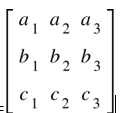Vectors FormulaThe formula for vectors are as stated below | |
| Description | Formula |
| Position Vector of a Point | If a and b are positive vectors of two points A and B, then AB =b- a
AB= |( a ) ⃗-b ⃗ |∣(a)⃗−b⃗∣
|
| Scalar Product of Two vectors | a .b= a b cosθ , where a , b are the magnitude of a and b respectively and θ is the angle between a and b
|
| Vector Product of Two vectors |
|
| Scalar Triple Product |
a ⃗×b ⃗.c ⃗=|a ⃗ ||b ⃗ ||c ⃗ | □sin sin θ □cos cos ∅a⃗×b⃗.c⃗=∣a⃗∣∣b⃗∣∣c⃗∣□sinsinθ□coscos∅
a ⃗.(b ⃗×c ⃗ )=(a ⃗×b ⃗ ).c ⃗ Or [a ⃗ b ⃗ c ⃗ ]=[b ⃗ c ⃗ a ⃗ ]=[c ⃗ a ⃗ b ⃗ ] a ⃗.(b ⃗×c ⃗ )=-a ⃗.(c ⃗×b ⃗) i.e. [a ⃗ b ⃗ c ⃗ ]=-[a ⃗ c ⃗ b ⃗]a⃗.(b⃗×c⃗)=(a⃗×b⃗).c⃗Or[a⃗b⃗c⃗]=[b⃗c⃗a⃗]=[c⃗a⃗b⃗]a⃗.(b⃗×c⃗)=−a⃗.(c⃗×b⃗)i.e.[a⃗b⃗c⃗]=−[a⃗c⃗b⃗]
a.b.c=
|
| Vector Triple Product | a ⃗×(b ⃗×c ⃗ )=(a ⃗.c ⃗ ) b ⃗-(a ⃗.b ⃗ ) c ⃗, (a ⃗×b ⃗ )×c ⃗=(a ⃗.c ⃗ ) b ⃗-(b ⃗.c ⃗)a ⃗a⃗×(b⃗×c⃗)=(a⃗.c⃗)b⃗−(a⃗.b⃗)c⃗,(a⃗×b⃗)×c⃗=(a⃗.c⃗)b⃗−(b⃗.c⃗)a⃗ In general: (a ⃗×b ⃗ )×c ⃗≠a ⃗×(b ⃗×c ⃗ )(a⃗×b⃗)×c⃗=a⃗×(b⃗×c⃗) |
Parabola formulaThe formula for parabola are as stated below | |
| Description | Formula |
| Equation of standard parabola: | The equation of parabola with focus at (a,0), a>0 and directrix x = -a is given as y^2=4axy2=4ax When vertex is (0, 0) then axis is given as y = 0 Length of latus rectum is equals to 4a Ends of the latus rectum are L(a, 2a) and L’(a, -2a). |
| Parametric representation | The point (x,y1) lies outside, on or inside the parabola which is given as y = 4ax Therefore, equation of parabola now becomes, 〖y_1〗^2-4ax≥0〖y1〗2−4ax≥0 Or 〖y_1〗^2-4ax<0〖y1〗2−4ax<0 |
| Line and a parabola | Length of the chord intercepted by the parabolay^2=4axy2=4ax on the line y = mx+c is given as 4/m^2 (√(a(1+m^2 )(a-mc) )4/m2(√(a(1+m2)(a−mc)) |
| Tangents to the parabola | Tangent of the parabola y^2=4axy2=4axis given as T = 0 y=mx+am , m≠0 is the tangent of parabola y^2=4ax at (a/m^2 ,2a/m)y2=4axat(a/m2,2a/m) |
| Normal to the parabola y2=4ax | Normal to the paraboly^2=4axy2=4ax is given as y-y_1=(-y_1)/2a (x-x_1 )y−y1=(−y1)/2a(x−x1) |
| A chord with a given middle point | The equation of the chord of parabola y^2=4axy2=4axwith midpoint (x1, y1) is given as T = S1. Here, S_1=y_1-4axS1=y1−4ax |
Definite Integration FormulaThe formula for definite integration are as stated below | |
| Description | Formula |
| Definite Integral as Limit Sum | ∫_a^b f(x)dx=∑_(r=1)^n hf(a+rh)∫abf(x)dx=∑(r=1)nhf(a+rh) Here h=(b-a)/nh=(b−a)/n is the length of each subinterval |
| Definite Integral Formula Using the Fundamental theorem of calculus | ∫_a^b f(x)dx=F(b)-F(a), where F^’ (x)=f(x)∫abf(x)dx=F(b)−F(a),whereF’(x)=f(x) |
| Properties of Definite Integral | ∫_a^b f(x).dx=∫_a^b f(t).dt∫abf(x).dx=∫abf(t).dt ∫_a^b f(x).dx=-∫_b^a f(x).dx∫_a^b cf(x).dx=c∫_a^b f(x).dx∫_a^b f(x)±g(x).dx=∫_a^b f(x).dx±∫_a^b g(x).dx∫_a^b f(x).dx=∫_a^c f(x).dx+∫_c^b f(x).dx∫_a^b f(x).dx=∫_a^b f(a+b-x).dx∫_0^a f(x).dx=∫_0^a f(a-x).dt∫_0^2a f(x).dx=2∫_0^a f(x).dx f(2a-x)=f(x) ∫_0^2a f(x).dx=0∫_(-a)^a f(x).dx=2∫_0^a f(x).dxf(-x)=f(x) |
| Definite Integrals involving Rational or irrational Expression | ∫_a^∞ dx/(x^2+a^2 )=π/2a∫a∞dx/(x2+a2)=π/2a
|
| Definite Integrals involving Trigonometric Functions |
|
| If f(x) is a periodic function with period T |
|
| Leibnitz Theorem | If F(x)=∫_(g(x))^(h(x)) f(t)dt, then (dF(x))/dx=h^’ (x)f(h(x))-g^’ (x)f(g(x))IfF(x)=∫(g(x))(h(x))f(t)dt,then(dF(x))/dx=h’(x)f(h(x))−g’(x)f(g(x)) |
Ellipse FormulaThe formula for ellipse are as stated below | |
| Description | Formula |
| Standard Equation | x^2/a^2 +y^2/b^2 =1, where
|
Auxiliary circle | x^2+y^2 = a^2 |
Parametric Representation | x=a cos θ & y=b sin θ |
Position of a Point w.r.t. an Ellipse | The point P(x_1,y_1) lies outside, inside or on the ellipse according as; (x_1^2)/a^2 + (y_1^2)/b^2 -1><or=0 |
Line and an Ellipse | The line y=mx+c meets the ellipse x^2/a^2 +y^2/b^2 =1in two points real, coincident or imaginary according as c^2is < =or > a^2 m^2+b^2 |
Tangents |
|
Normal | (a^2 x)/x_1 – (b^2 y)/y_1 =a^2-b^2, ax.secθ-by.cosecθ=(a^2-b^2 ), y=mx-(〖(a〗^2-b^2)m)/(√(a^2+b^2 ) m^2 ) |
Director Circle | x^2+y^2=a^2+b^2 |
Also see: JEE Maths Formulas Part 1
 Profile
Profile Settings
Settings Refer your friends
Refer your friends Sign out
Sign out








